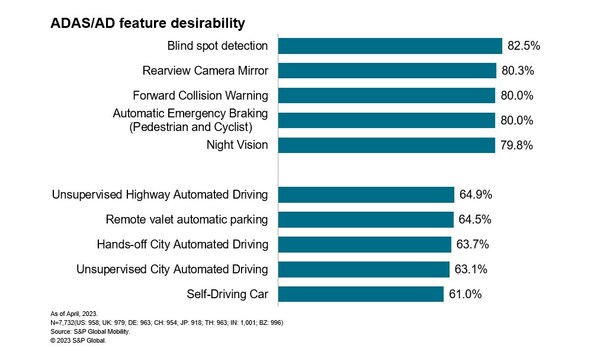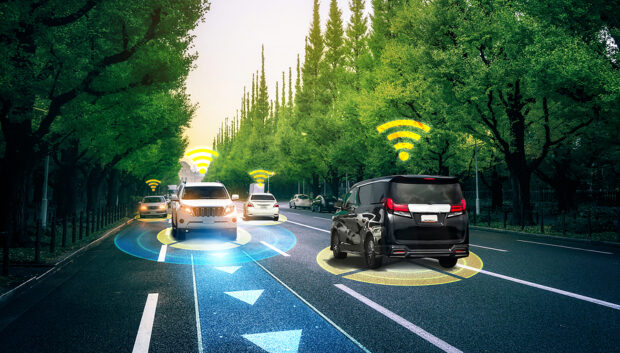Car buyers seek advanced driver assistance systems (ADAS) to enhance driver safety when purchasing new cars, with the expectation the system will be standard in new luxury and mainstream vehicles.
But the same feelings do not apply when ADAS is applied to autonomous driving systems, according to a recent consumer survey conducted by S&P Global Mobility, indicating that as the amount of vehicle automation increases, consumer desire decreases.
The survey found trust and familiarity remain barriers to car shoppers adopting autonomous driving technology.
Each of the five most-desired ADAS features improved safety. Blind spot warning ranked as the most desired safety technology, with 83 percent of consumers seeking this feature.
More than 80 percent of consumers surveyed wanted forward collision warning and rear mirror cameras.
Other top-five desired features included automatic emergency braking (AEB) for vehicles and pedestrians, as well as night vision.

Source: S&P Global Mobility
“Exposure is helping to drive much of the desirability for these features,” said Yanina Mills, senior technical research analyst at S&P Global Mobility.
While autonomous driving features add convenience by reducing the tedium of driving, the report found they fall short of ADAS safety features when it comes to buyer desirability.
“Safety versus convenience operate in two different ballparks of interest,” according to Brock Walquist, senior technical research analyst at S&P Global Mobility.
One hindrance is that consumer experience with self-driving remains nearly non-existent, inhibiting its desirability, the researchers said.
While many available automated safety features poll in the 80th percentile range, only 61 percent of the 7,732 global respondents expressed interest in self-driving, the research found, making it the least desirable ADAS feature listed in the survey.
Consumers prefer automated driving features where the driver maintains more control, S&P Global Mobility found. Only 69 percent of consumers desire Level 2 autonomy. Even fewer (65 percent), desire Level 2+ hands-off automated highway driving.
Of those polled, 53 percent of consumers felt that an autonomous car would drive more efficiently than a normal car, 48 percent felt it would be safer, and 27 percent said they would use it to relieve tedious driving conditions.
Interestingly, consumer sentiment surrounding self-driving cars varies globally. Consumers in Mainland China have consistently shown the highest desirability scores for self-driving technology, the report found, while consumers in the U.S., UK and Germany show the lowest scores.
“Consumers don’t exactly know how it is going to work. There is confusion,” Mills said. “They are asking, ‘Is it self-driving, or is it just going to help me a bit and I still have to focus?'”
The evolving nature of automated driving poses challenges — both to original equipment manufacturers who want to sell the systems and to consumers who are weighing their purchase.
The researchers found that automakers will need to better define the benefits of autonomy to improve desirability among consumers.





















 Slideshow: Carrier Management’s 2025 Top Editor’s Picks (Unlocked)
Slideshow: Carrier Management’s 2025 Top Editor’s Picks (Unlocked)  California Workers Comp Combined Ratio for 2024 Highest in 20-Plus Years
California Workers Comp Combined Ratio for 2024 Highest in 20-Plus Years  Artificial Intelligence Is Rewriting the Rules for Commercial Lines
Artificial Intelligence Is Rewriting the Rules for Commercial Lines  Why the Middle Market Matters and How Insurers Can Capture It
Why the Middle Market Matters and How Insurers Can Capture It 